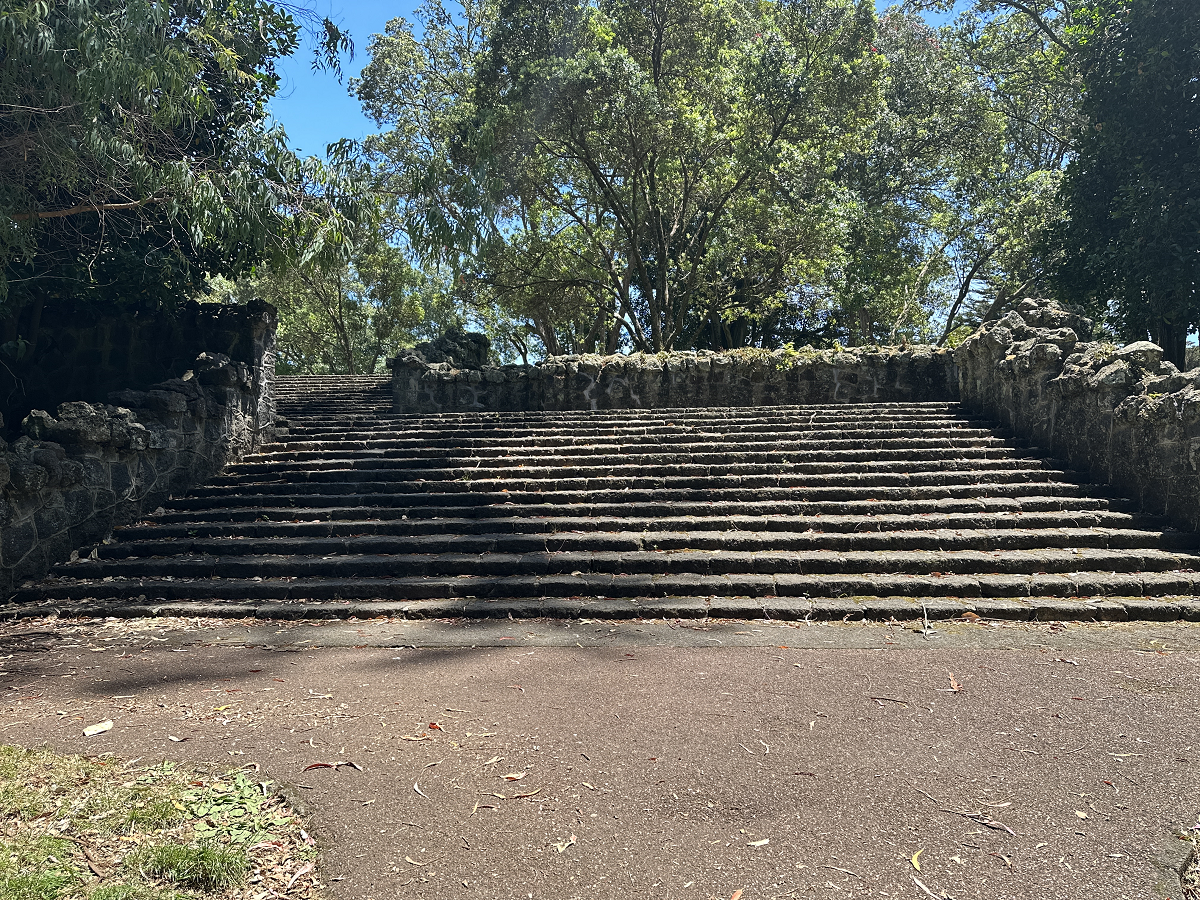Heritage
stonework histories
You’ve likely seen the various stonework features throughout Cornwall Park and Maungakiekie/One Tree Hill. Although, have you heard where they came from, how they were built, and what they represent? Enjoy a reading tour of our heritage sites based on the shared theme of the material they were made from, beginning with our Rongo Stone all the way to the Obelisk upon the summit.
Rongo Stone
On our first stop, we will visit the Rongo Stone near the main barbecue area.
Our Rongo Stone is said to be an ancient representation of the Māori kūmara god, and would have traditionally been set up in kūmara gardens to ensure a good harvest. The stone is of great archeological significance, and was originally brought to Cornwall Park by Sir John in 1890 after being retrieved from the roadside at the foot of Te Tātua-a-Riukiuta (Three Kings volcano). This particular stone got its name because it travelled around to many different Māori settlements, finally resting at Cornwall Park. It is thought to have been originally located near Te Arai, north of Auckland. Stones such as this were often focal points of tūāhu, ceremonial places.
The Māori name for the stone, Te Toka i Tawhio, roughly translates to "The stone which has travelled around".
Stone Walls
Our next stop is the stone walls so prevalent throughout the park.
A special quality of the rocks used to build these walls is that they have been used by both Māori and European farmers, a continuous cycle of reuse, and a link to the past still evident today. Many of the rocks are scoria, formed during the eruption of Maungakiekie 67,000 years ago. These rocks were first used in Māori kūmara gardens to create a glasshouse effect. Later, when Europeans started farming the surrounding land in 1844 they used scoria stones to build dry stone walls, a tradition dating back to the Neolithic age in Europe.


Memorial & Kauri Steps
The Memorial Steps below Acacia Cottage were constructed in 1956 in Sir John Logan Campbell's memory. Built using local volcanic basalt rock, this spectacular flight of stone steps was designed by prominent New Zealand architects William Gummer and Reginald Ford. A bronze plaque set into the stonework of the steps records Sir John's arrival in New Zealand, his association with Governor Hobson and his burial on the summit of Maungakiekie/One Tree Hill. Immediately below steps is the Native Arboretum, planted in the mid-1960s.
Meanwhile the Kauri Steps lead down through a clearing of eucalyptus trees and our protected Kauri Grove, a more secluded spot in Cornwall Park. The Kauri Steps are one of the two spots available for weddings in the park, and many of our visitors have a special memory made there.
Campbell Statue & Fountain
Taking a trip all the way to Epsom, we find this statue of Sir John Logan Campbell that was unveiled in 1906 in front of 300 members of the public. It was paid for by public subscription, in honour of Sir John and the work he had done for Auckland. Think of it as an early version of crowdfunding! You can see it at the Campbell Crescent entrance to the park, which has recently undergone an upgrade, with the surrounding gardens having been planted with over 4000 native plants, paths and seating improved, and a system upgrade to ensure the fountain water is recycled.
While the statue itself is made out of bronze and was constructed in England by British sculptor Henry Pegram, it sits upon a pedestal of highly polished rose-coloured Aberdeen granite with gold lettering inscribed. Both the statue and pedestal took two years to create and ship to Aotearoa New Zealand.
Obelisk
For the last stop of our tour, we venture all the way to the summit of our neighbouring park Maungakiekie/One Tree Hill, where we find ourselves at the Obelisk which can be seen from afar.
The obelisk was completed by 1940, fulfilled at the request of Sir John Logan Campbell's will 30 years after his death. The obelisk is situated near Sir John's grave, but it was not intended to honour him, rather it was built as a permanent record of his admiration for the achievements and character of Māori. The base is formed from rusticated basalt blocks and rubbed stone wedges,with the cast bronze figure of Maori rangatira having been sculpted by Richard Oliver Gross. The Obelisk's official unveiling was delayed until 1948, after the end of WW2, in keeping with the Māori custom of not holding such ceremonies during a time of bloodshed.
Did any of these stoneworks catch your eye? Come see them in-person and be sure the visit Huia Lodge when you do for a map brochure of our heritage sites.
